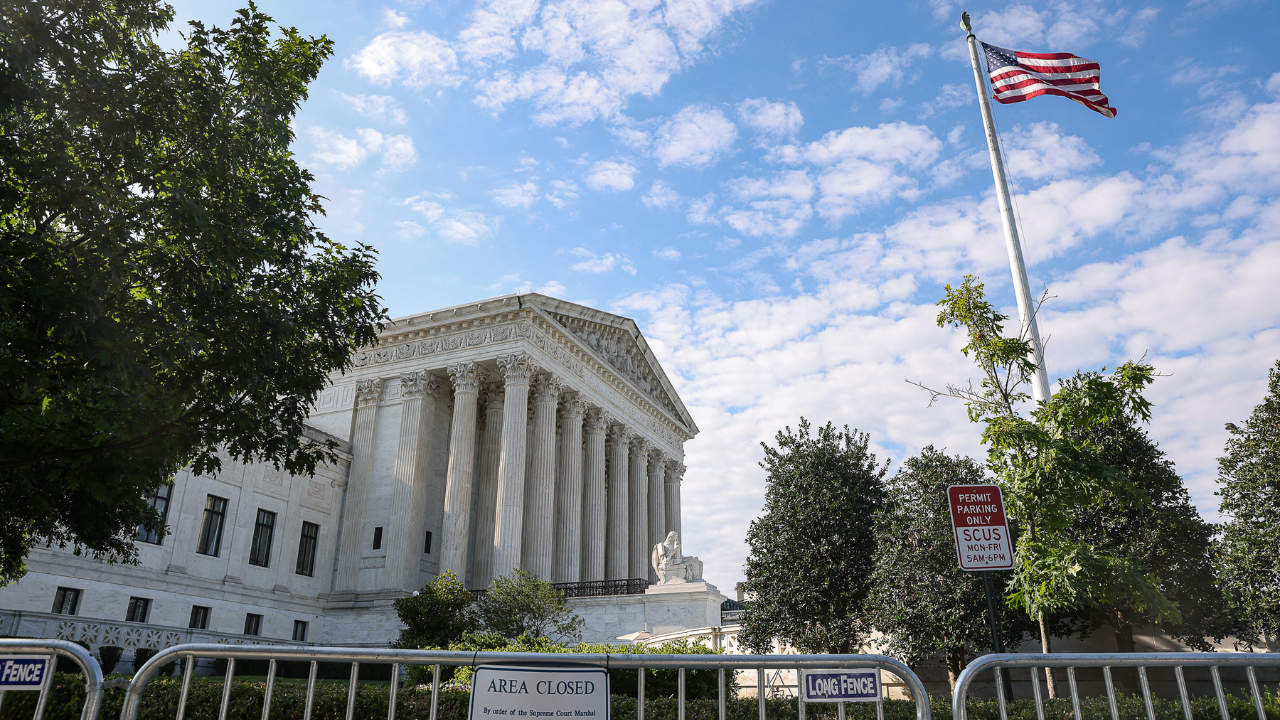The Occupational Safety and Health Administration proposed a rule Tuesday outlining steps employers must take to protect indoor and outdoor workers from the risk of heat illness, the first major regulation aimed at preventing heat-related deaths on the job.
West
US Supreme Court upholds controversial anti-camping laws used against homeless people in Oregon city

- The U.S. Supreme Court upheld anti-camping laws in Grants Pass, Oregon, allowing authorities to prevent homeless individuals from sleeping in public parks and streets.
- The court’s 6-3 decision reversed a lower court ruling that enforcing these laws without available shelter violated the Eighth Amendment’s prohibition on cruel and unusual punishment.
- Grants Pass ordinances prohibit sleeping on public streets with blankets or bedding, imposing fines and possible jail time.
The U.S. Supreme Court upheld on Friday anti-camping laws used by authorities in an Oregon city to stop homeless people from sleeping in public parks and public streets – a ruling that gives local and state governments a freer hand in confronting a national homelessness crisis.
The justices ruled 6-3 to overturn a lower court’s decision that found that enforcing the ordinances in the city of Grants Pass when no shelter space is available for the homeless violates the U.S. Constitution’s Eighth Amendment prohibition on “cruel and unusual” punishments. Various jurisdictions employ similar laws.
The court’s conservative justices were in the majority, while its three liberal members dissented.
TRUST IN SUPREME COURT PLUNGES AHEAD OF KEY DECISIONS ON PRESIDENTIAL IMMUNITY, JAN. 6
Homelessness remains a complex problem for public officials in the United States as many municipalities experience chronic shortages of affordable housing. On any given night, more than 600,000 people are homeless, according to U.S. government estimates.
The U.S. Supreme Court is seen in Washington, DC, on June 28, 2024. The U.S. Supreme Court upheld on Friday anti-camping laws used by authorities in an Oregon city to stop homeless people from sleeping in public parks and public streets – a ruling that gives local and state governments a freer hand in confronting a national homelessness crisis. (Valerie Plesch/Bloomberg via Getty Images)
The case focused on three ordinances in Grants Pass, a city of roughly 38,000 people in southwestern Oregon, that together prohibit sleeping in public streets, alleyways and parks while using a blanket or bedding. Violators are fined $295. Repeat offenders can be criminally prosecuted for trespass, punishable by up to 30 days in jail.
Advocates for the homeless, various liberal legal groups and other critics have said laws like these criminalize people simply for being homeless and for actions they cannot avoid, such as sleeping in public. They point to a 1962 Supreme Court ruling that the Eighth Amendment barred punishing individuals based on their status rather than their conduct.
SUPREME COURT RULES ON CHALLENGE TO BIDEN ADMIN’S EFFORT TO INFLUENCE SOCIAL MEDIA
A point of contention during the Supreme Court’s arguments in the case in April was whether homelessness can be deemed a status that would prohibit enforcing local laws.
President Joe Biden’s administration agreed with the plaintiffs that Grants Pass cannot enforce an “absolute ban” on sleeping in the city – which effectively criminalizes homelessness – but suggested the rulings by the lower courts against the city were too broad and should be reconsidered.
Proponents, including various government officials, have called such laws a necessary tool for maintaining public safety.
The case, which began in 2018, involved three homeless people who filed a class-action lawsuit seeking to block the measures impacting them in Grants Pass. One of the plaintiffs has since died.
U.S. Magistrate Judge Mark Clarke ruled that the city’s “policy and practice of punishing homelessness” violates the Eighth Amendment and barred it from enforcing the anti-camping ordinances. The San Francisco-based 9th U.S. Circuit Court of Appeals upheld Clarke’s injunction against the ordinances.
The city had defended itself in the case in part by noting that homeless people have alternatives outside the city, including nearby undeveloped federal land, county campsites or state rest stops. The judge said that argument “sheds light on the city’s attitude towards its homeless citizens” by seeking to drive them out or punish them if they stay.
Read the full article from Here

Oregon
Extreme, long-lasting heat dome to spike Oregon temps near 110: ‘This will be remembered’

An extreme and long-lasting heat dome is forecast to hit Oregon late this week, spiking temperatures as high as 110 degrees and potentially lasting a week or more.
The blistering temperatures could impact Oregon’s electrical grid, increase wildfire danger and make urban centers deadly for the elderly and those without air conditioning, officials said.
The heat is forecast to begin Thursday night — the Fourth of July — and peak Friday and Saturday. In the Willamette Valley, there’s a 15-20% chance of temperatures reaching 110 degrees Saturday and a good chance of three days above 100 degrees.
In Medford, there’s a 30-40% chance of temperatures reaching 115 degrees and five days forecast above 100 degrees.
“I think this is an event that will be remembered,” National Weather Service meteorologist Shawn Weagle said. “This has the potential to be a high impact event.”
The heat isn’t expected to reach the levels of the 2021 heat dome that shattered state records with temperatures of 117 to 118. However, this event is expected to last longer, with a second heat wave possible next week.
“There just isn’t much of a break,” Weagle said.
Deadly heat across Western Oregon
The most concerning time period is Friday, Saturday and Sunday, when temperatures are forecast to reach 98 to 105 across wide swaths of the Willamette Valley. Nighttime temperatures may only drop as low as the 70s.
The farther south you go, the hotter it gets. Medford’s forecast is a blistering string of high temperatures — 104 on Thursday, 110 on Friday, 111 on Saturday, 108 on Sunday and 104 on Monday.
“We’re most concerned about people without access to air conditioning and in apartments,” Weagle said. “The fatalities we saw in 2021 were people without access to cooling.”
In the 2021 heat dome, 123 people died in Oregon because of the heat wave, according to the Center for Health Statistics.
How long will the heat wave in Oregon last?
The first heat wave lasts from Thursday night to Sunday evening, Weagle said, before it breaks somewhat by Monday and Tuesday.
Problem is, “the climate prediction center is putting a moderate risk that the heat lasts into a second week,” he said. “If that happens, we could see a brief cool down before it heats back up for a prolonged period.”
The concern is two weeks of temperatures above 90 with multiple hits above 100 degrees, Weagle said.
“The longer these (heat waves) last the harder they are on people,” he said.
Escape from the heat on the Oregon Coast
The best place to escape the heat, as ever, will be the Oregon Coast, where temperatures are forecast to stay in the 70s, with Tillamook and Astoria reaching the 80s.
“They’re still forecast to get that onshore flow from the ocean, which will cool things down” Weagle said.
Wildfire danger likely to increase in Oregon
Wildfire season has stayed quiet in western Oregon so far this season, with cooler and somewhat wetter conditions than normal. Central Oregon has been more active.
However, a long-stretch of such hot and dry weather could dry out fuels rapidly and increase wildfire danger quickly, leading to a longer summer stretch at high wildfire risk.
What is a heat dome?
As for what’s forecast to cause the heat dome, it’s “a very strong ridge of high pressure that pushes the air down and heats it up,” Weagle said. “Combined with the strong sunshine this time of year and the hot air mass from the southwest, all those factors come together in this heat dome.”
Zach Urness has been an outdoors reporter in Oregon for 16 years and is host of the Explore Oregon Podcast. Urness is the author of “Best Hikes with Kids: Oregon” and “Hiking Southern Oregon.” He can be reached at zurness@StatesmanJournal.com or (503) 399-6801. Find him on X at @ZachsORoutdoors.
Utah
Utah family mourns loss of son after construction accident

SALT LAKE CITY — A Utah family is mourning the death of their son after a fall on Friday. The 14-year-old was working on a job site with his stepdad when he fell through a skylight.
Keenan Conte’s family says he loved music and hanging out with family and cousins. They say they are going to miss his big personality every day.
“We have four kids and they’re all best friends,” says Bryant Coburn, Keenan’s stepdad.
When Bryant and Keenan’s mom, Rachelle Coburn realized their son would not survive his injuries, they faced a tough decision on whether to donate his organs.
“Anytime he could help someone he was helping them,” Rachelle Coburn said, which is ultimately why they made the quick decision on organ donation. in “In order to be able to salvage organs it took our time with him from hours to minutes but that’s what Keenan would want.”
They say Keenan was a homebody who loved music.
Rachelle Coburn says she always knew her son was special, but now she knows others thought so too.
“In his passing, I realized it’s not just me, his mom being biased,” Rachelle Coburn said. “Everyone that has reached out has said how kind and caring he was, like just the best friend.”
There is a *GoFundMe set up to help the family.
*KSL TV does not assure that the money deposited to the account will be applied for the benefit of the persons named as beneficiaries. If you are considering a deposit to the account, you should consult your own advisors and otherwise proceed at your own risk.
Washington
OSHA proposes rule to protect workers exposed to extreme heat

“The purpose of this rule is simple. It is to significantly reduce the number of work-related deaths, injuries and illnesses suffered by workers who are exposed to excessive heat and exposed to these risks while simply doing their jobs,” OSHA Assistant Secretary of Labor Doug Parker said on a call with reporters.
“Whether they are making deliveries, carrying mail all day, working construction, picking vegetables, repairing power lines, doing landscaping. It’s these things that put workers at risk.”
OSHA officials have been working on the proposed regulation for more than two years at the urging of public health and climate advocates.
The proposal comes as summertime heat envelopes the United States and the hottest month of the year gets underway. At the beginning of this week, over 60 million Americans were under heat alerts.
Excessive heat warnings now cover much of California, including in and around San Francisco, and the National Weather Service office that serves much of California’s Central Valley warned of a “dangerous, prolonged heat wave that will last several days.” Southeastern states are also facing hot and soupy weather and at least 45 million Americans will probably have to endure highs at or above 100 degrees this week.
Under the proposed rule issued Tuesday, OSHA would adopt two heat index thresholds that would apply nationally and would factor in humidity as well as temperature. One, at 80 degrees Fahrenheit, would require employers to provide drinking water and break areas that workers can use as needed. Employers would also need to have a plan for new and returning workers to gradually increase their workload so their bodies adjust to the heat.
More protections would kick in at 90 degrees, including monitoring for signs of heat illness and mandatory 15 minute rest breaks every two hours. Employers would be required to check on people working alone every few hours and to issue a hazard alert, reminding their workers of the importance of staying hydrated.
Juley Fulcher, a worker health advocate for the nonprofit Public Citizen, which has pushed for a national heat standard, said the proposal is based on scientific research on how the body responds to heat and borrows from state workplace heat safety laws. So far, only five states have such protections: California, Colorado, Minnesota, Oregon and Washington. Workers in Maryland could soon gain protections — there is a draft rule that is not yet final.
Fulcher praised the OSHA proposal, saying the agency had “done a really good job.” Although some Americans might balk at the suggestion they need protection from 80 degree weather, Fulcher said it’s important to remember that official temperature readings are taken in the shade. Once you factor in sunlight and humidity, an 80 degree day can feel more like 95 or 100, she said.
“If you’re doing really heavy work, you’re generating a lot of internal heat in addition to that external heat,” she said. “You’re not going to be able to cool off at those temperatures.”
The rule doesn’t cover everyone. “Sedentary” employees are exempt from the protections, as are those in indoor job sites kept below 80 degrees, emergency response workers and remote employees. And, because OSHA regulations do not extend to public employees, the regulation won’t apply to government workers and public school teachers, many of whom are confronting increasingly high temperatures in school buildings without air conditioning.
Some businesses and industry groups are gearing up for a battle over a regulation many see as burdensome, redundant and expensive.
Critics have made their displeasure known in letters to the agency. Some industries have argued they are already protecting employees from heat and that a new regulation would be duplicative or, worse, get in the way of what they’re doing. They have pushed back against the rule’s expected acclimatization requirements, which would mandate a gradual ramping up of work hours during high heat. Some have questioned the entire initiative, saying that a workplace heat rule is unnecessary because not many workers die of heat exposure.
From 1992-2019, the Bureau of Labor Statistics found there were an average of 32 heat-related workplace fatalities per year. There were 43 such deaths in 2022, up from 36 in 2021.
Agency officials and public health advocates say these numbers underestimate the scale of the problem, given underreporting and the difficulty of attributing a death to heat. Workplace data aside, deaths from heat in the U.S. have steadily increased in recent years, exceeding 2,200 last year.
-

 News1 week ago
News1 week agoA Florida family is suing NASA after a piece of space debris crashed through their home
-

 World1 week ago
World1 week agoIsrael accepts bilateral meeting with EU, but with conditions
-

 World1 week ago
World1 week agoNew Caledonia independence activists sent to France for detention
-

 World1 week ago
World1 week agoNetanyahu says war will continue even if ceasefire deal agreed with Hamas
-

 News1 week ago
News1 week agoArkansas police confirm 4th victim died in grocery store shooting
-

 Movie Reviews1 week ago
Movie Reviews1 week agoFilm Review: Everyday of the Dead (2023) by Yuyuma Naoki
-

 Politics1 week ago
Politics1 week agoDeSantis signs bill allowing residents to kill bears, vetoes bill that fines slow left lane drivers
-

 Politics1 week ago
Politics1 week agoBiden official says past social media posts don’t reflect ‘current views,’ vows to support admin ‘agenda’













